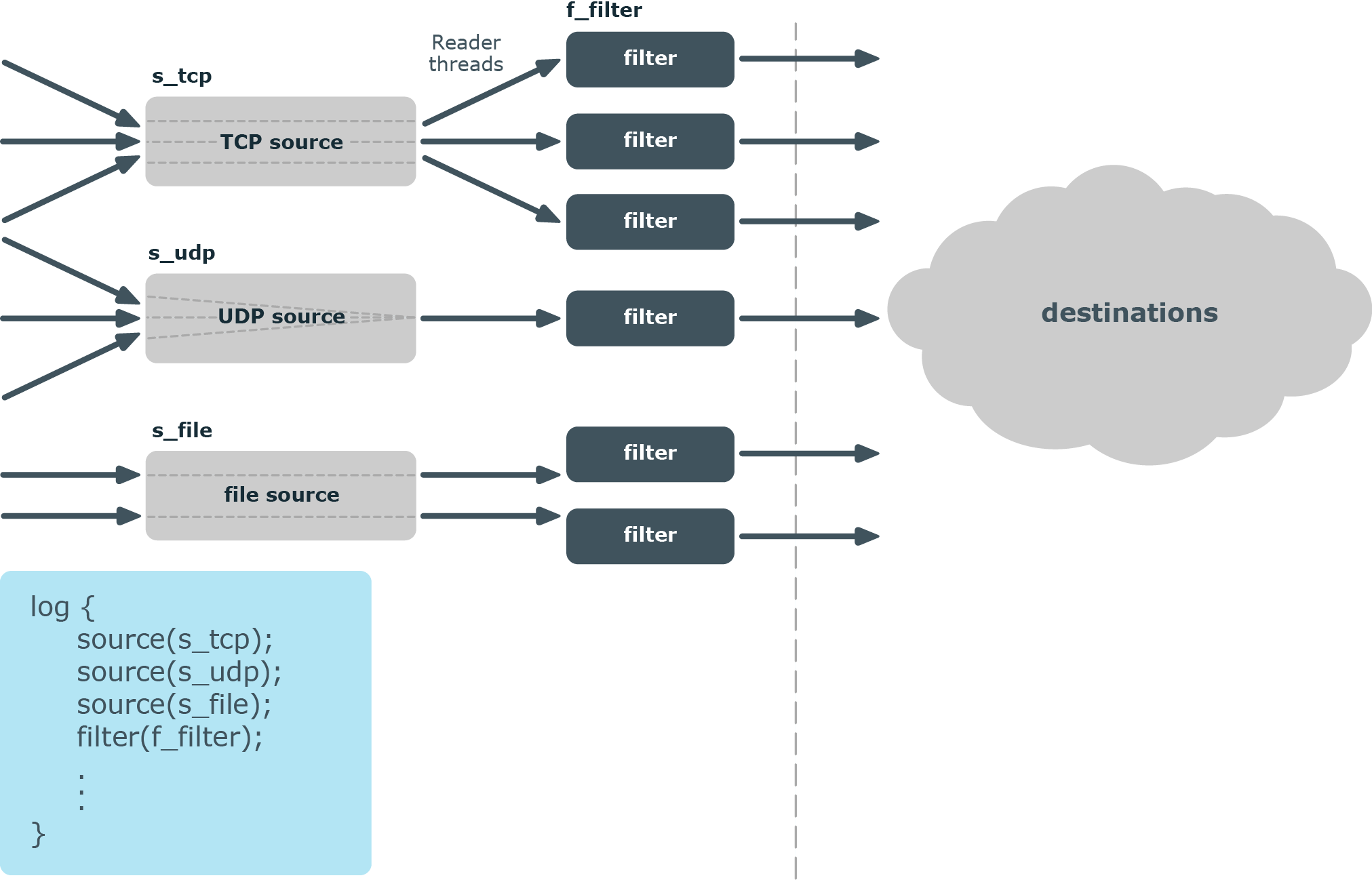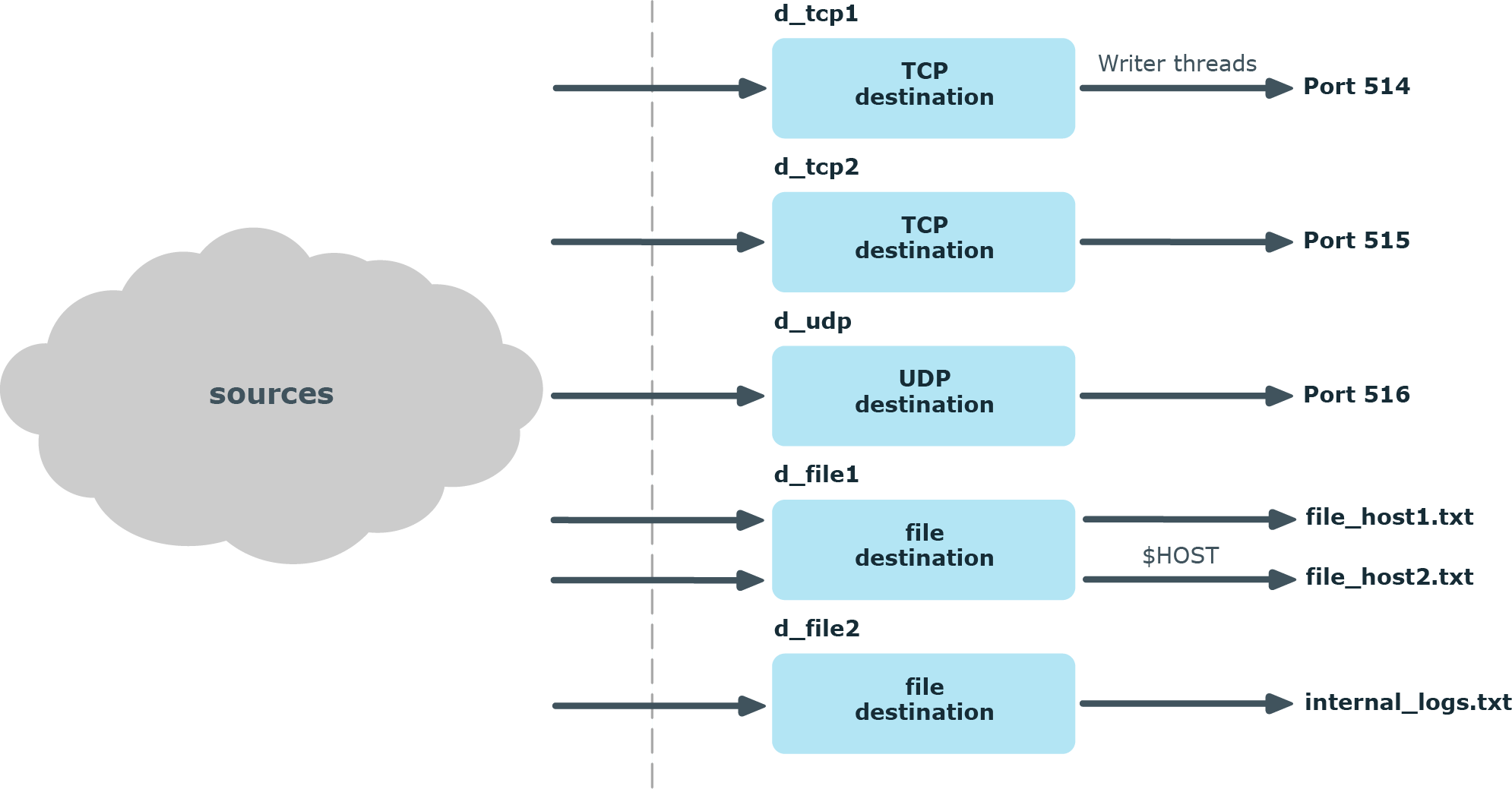Starting with version
Multithreading and scaling in syslog-ng PE
Multithreading concepts of syslog-ng PE
This section is a brief overview on how syslog-ng PE works in multithreaded mode. It is mainly for illustration purposes: the concept has been somewhat simplified and may not completely match reality.
NOTE: The way syslog-ng PE uses multithreading may change in future releases. The current documentation applies to version 7.
syslog-ng PE always uses multiple threads:
-
A main thread that is always running
-
A number of worker threads that process the messages. You can influence the behavior of worker threads using the threaded() option and the --worker-threads command-line option.
-
Some other, special threads for internal functionalities. For example, certain destinations run in a separate thread, independently of the multithreading (threaded()) and --worker-threads settings of syslog-ng PE.
The maximum number of worker threads syslog-ng PE uses is the number of CPUs or cores in the host running syslog-ng PE (up to 64). You can limit this value using the --worker-threads command-line option that sets the maximum total number of threads syslog-ng PE can use, including the main syslog-ng PE thread. However, the --worker-threads option does not affect the supervisor of syslog-ng PE. The supervisor is a separate process (see The syslog-ng manual page), but certain operating systems might display it as a thread. In addition, certain destinations always run in a separate thread, independently of the multithreading (threaded()) and --worker-threads settings of syslog-ng PE.
When an event requiring a new thread occurs (for example, syslog-ng PE receives new messages, or a destination becomes available), syslog-ng PE tries to start a new thread. If there are no free threads, the task waits until a thread finishes its task and becomes available. There are two types of worker threads:
-
Reader threads read messages from a source (as many as possible, but limited by the log-fetch-limit() and log-iw-size() options. The thread then processes these messages, that is, performs filtering, rewriting and other tasks as necessary, and puts the log message into the queue of the destination. If the destination does not have a queue (for example, usertty), the reader thread sends the message to the destination, without the interaction of a separate writer thread.
-
Writer threads take the messages from the queue of the destination and send them to the destination, that is, write the messages into a file, or send them to the syslog server over the network. The writer thread starts to process messages from the queue only if the destination is writable, and there are enough messages in the queue, as set in the flush-lines() and the flush-timeout() options. Writer threads stop processing messages when the destination becomes unavailable, or there are no more messages in the queue.
Sources and destinations affected by multithreading
The following list describes which sources and destinations can use multiple threads. Changing the --worker-threads command-line option changes the number of threads available to these sources and destinations.
-
The tcp and syslog(tcp) sources can process independent connections in separate threads. The number of independent connections is limited by the max-connections() option of the source. Separate sources are processed by separate thread, for example, if you have two separate tcp sources defined that receive messages on different IP addresses or port, syslog-ng PE will use separate threads for these sources even if they both have only a single active connection.
-
The udp, file, and pipe sources use a single thread for every source statement.
-
The udp-balancer source uses a thread for each listener configured in its listeners() option.
-
The tcp, syslog, and pipe destinations use a single thread for every destination.
-
The file destination uses a single thread for writing the destination file, but may use a separate thread for each destination file if the filename includes macros.
Sources and destinations not affected by multithreading
The following list describes sources and destinations that use a separate thread even if you disable multithreading in syslog-ng PE, in addition to the limit set in the --worker-threads command-line option.
-
The logstore destination uses separate threads for writing the messages from the journal to the logstore files, and also for timestamping. These threads are independent from the setting of the --worker-threads command-line option.
-
Every sql destination uses its own thread. These threads are independent from the setting of the --worker-threads command-line option.
-
The java destinations use one thread, even if there are multiple Java-based destinations configured. This thread is independent from the setting of the --worker-threads command-line option.
Configuring multithreading
Starting with version
-
Globally using the threaded(yes) option.
-
Separately for selected sources or destinations using the flags("threaded") option.
Example: Enabling multithreading
To enable multithreading globally, use the threaded option:
options {threaded(yes) ; };
To enable multithreading only for a selected source or destination, use the flags("threaded") option:
source s_tcp_syslog { network(ip(127.0.0.1) port(1999) flags("syslog-protocol", "threaded") ); };Optimizing multithreaded performance
Sources
File sources scale based on the number of files that the syslog-ng PE is reading. If there are 10 files all coming to the same source, then that source can use 10 threads, one thread for each file.
NOTE: When collecting log messages from multiple files, the file source is a wildcard-file() source.
TCP-based network sources scale based on the number of active connections. This means that if there are 10 incoming connections all coming to the same source, then that source can use 10 threads, one thread for each connection.
NOTE: UDP-based network sources do not scale by themselves because they always use a single thread. If you want to handle a large number of UDP connections, it is best to configure a subset of your clients to send the messages to a different port of your syslog-ng server, and use separate source definitions for each port.
Figure 43: How multithreading works — sources

Message processors
Message processors — such as filters, rewrite rules, and parsers — are executed by the reader thread in a sequential manner.
For example, if you have a log path that defines two sources and a filter, the filter will be performed by the source1 reader thread when log messages come from source1, and by the source2 reader thread when log messages come from source2. This means that if log messages come from both source1 and source2, they will both have a reader thread and that way filtering will be performed simultaneously.
NOTE: This is not true for PatternDB because it uses message correlation. When using PatternDB, it runs in only one thread at a time, and this significantly decreases performance.
Destinations
In syslog-ng, every destination has a writer thread. To improve scaling on the destination side, use multiple destinations instead of one.
For example, when sending messages to a syslog-ng server, you can use multiple connections to the server if you configure the syslog-ng server to receive messages on multiple ports, and configure the clients to use both ports.
When writing the log messages to files, use macros in the filename to split the messages to separate files (for example, using the ${HOST} macro). Files with macros in their filenames are processed in separate writer threads.
Figure 44: How multithreading works — destinations

